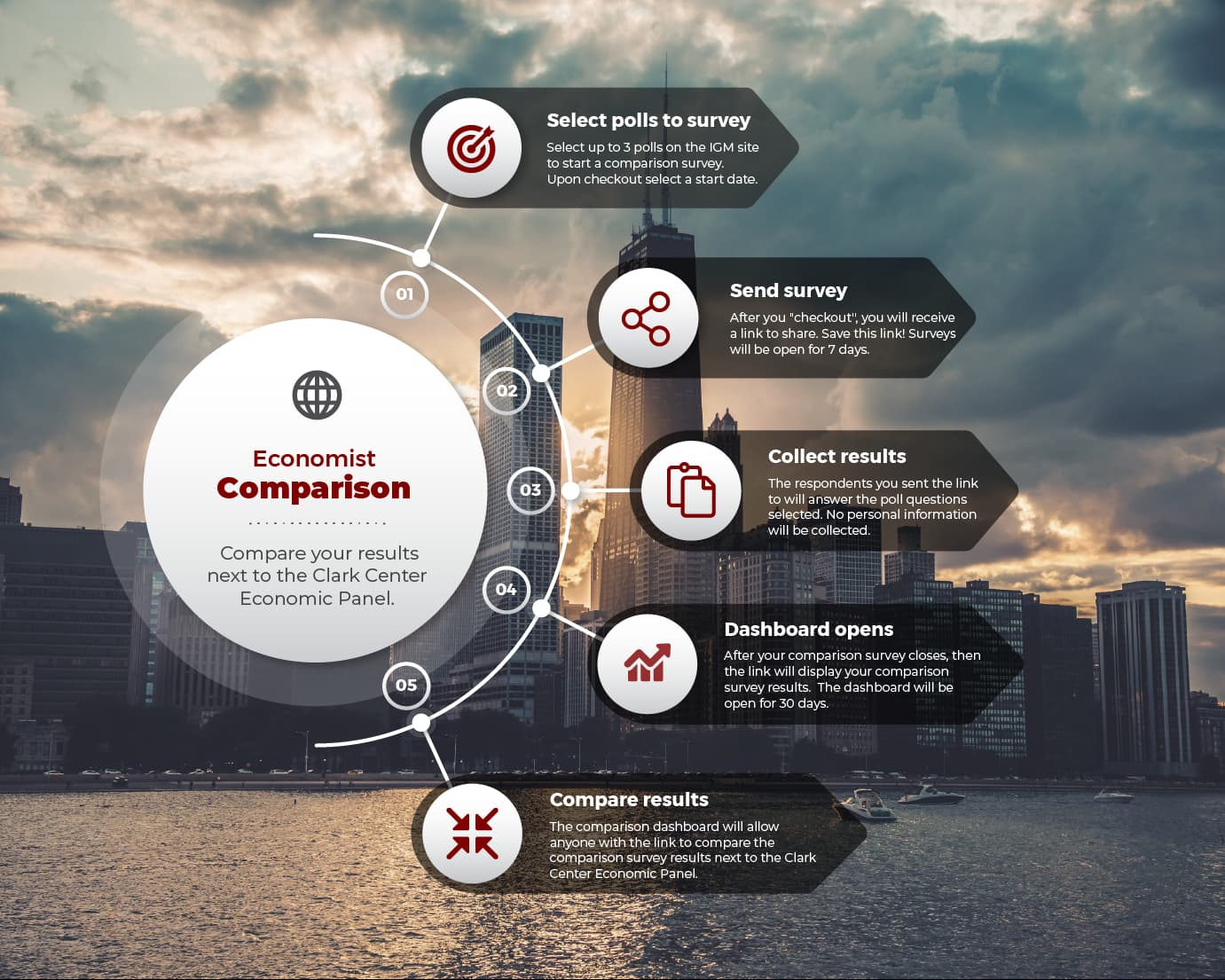Question A:
Financial regulators in the US and Europe lack the tools and authority to deter runs on banks by uninsured depositors.
Responses
Responses weighted by each expert's confidence
Question B:
Not guaranteeing uninsured deposits at Silicon Valley Bank in full would have created substantial damage to the US economy.
Responses
Responses weighted by each expert's confidence
Question C:
Fully guaranteeing uninsured deposits at Silicon Valley Bank substantially increases banks’ incentives to engage in excessive risk-taking.
Responses
Responses weighted by each expert's confidence
Question A Participant Responses
| Participant | University | Vote | Confidence | Bio/Vote History |
|---|---|---|---|---|
 John Campbell |
Harvard | Bio/Vote History | ||
|
As long as some depositors remain uninsured, runs remain possible as we have recently seen among depositors of US regional banks. The risk can be reduced by more stringent capital requirements and regulation of bank risktaking, but cannot be reduced to zero.
|
||||
    John Cochrane |
Hoover Institution Stanford | Bio/Vote History | ||
|
They just showed they have a bazooka: blanket guarantee. They have many other tools to stop runs should they choose to use them. But we shouldn't be here. Failing to see interest rate risk and run prone deposits is a huge failure of the regulatory architecture.
|
||||
    Francesca Cornelli |
Northwestern Kellogg | Did Not Answer | Bio/Vote History | |
|
|
||||
    Douglas Diamond |
Chicago Booth | Bio/Vote History | ||
|
The supervisors need to use the measures they have to measure market values of assets and the effects of interest rates on large uninsured deposit supply. If they are to use only formulas, they need to change their rules and measures.
|
||||
    Darrell Duffie |
Stanford | Bio/Vote History | ||
|
Regulators can impose relatively severe capital and liquidity rules.
-see background information here |
||||
    Janice Eberly |
Northwestern Kellogg | Did Not Answer | Bio/Vote History | |
|
|
||||
    Xavier Gabaix |
Harvard | Bio/Vote History | ||
|
|
||||
    Itay Goldstein |
UPenn Wharton | Bio/Vote History | ||
|
|
||||
    John Graham |
Duke Fuqua | Bio/Vote History | ||
|
Regulators have tools to deter bank runs ... but not stop them altogether
|
||||
    Campbell R. Harvey |
Duke Fuqua | Bio/Vote History | ||
|
With a fractional reserve system and limited insurance, you have run risk. The Fed should revisit their opposition to narrow banks (ultra-safe commercial banks that receive deposits and park them all at the Fed - no loan book).
|
||||
    David Hirshleifer |
USC | Bio/Vote History | ||
|
|
||||
    Harrison Hong |
Columbia | Bio/Vote History | ||
|
Could increase deposit insurance but not clear that is in the toolkit of financial regulators and requires congressional approval.
|
||||
    Wei Jiang |
Emory Goizueta | Bio/Vote History | ||
|
|
||||
    Steven Kaplan |
Chicago Booth | Bio/Vote History | ||
|
They do have some tools -- regulatory supervision. Question is whether they use them.
|
||||
    Anil Kashyap |
Chicago Booth | Bio/Vote History | ||
|
Announcing after one starts that everything will be backed does not count in my view.
|
||||
    Ralph Koijen |
Chicago Booth | Bio/Vote History | ||
|
|
||||
    Camelia Kuhnen |
UNC Kenan-Flagler | Bio/Vote History | ||
|
|
||||
    Andrew Lo |
MIT Sloan | Bio/Vote History | ||
|
Do the math...
|
||||
    Michelle Lowry |
Drexel LeBow | Bio/Vote History | ||
|
|
||||
    Sydney Ludvigson |
NYU | Bio/Vote History | ||
|
|
||||
    Matteo Maggiori |
Stanford GSB | Bio/Vote History | ||
|
|
||||
    Gregor Matvos |
Northwestern Kellogg | Bio/Vote History | ||
|
Guaranteeing all uninsured deposits would stop runs as long as the guarantee is considered credible by depositors.
|
||||
    Tobias Moskowitz |
Yale School of Management | Bio/Vote History | ||
|
|
||||
    Stefan Nagel |
Chicago Booth | Bio/Vote History | ||
|
They don't lack the tools, but the problem is that using them to deter runs effectively makes uninsured depositors insured, which defeats the purpose of limits on deposit insurance.
|
||||
    Jonathan Parker |
MIT Sloan | Bio/Vote History | ||
|
Focusing on the US, the Fed can lend freely to solvent banks (and bank holding companies) which experience runs by uninsured depositors. And regulators can enforce little risk taking, e.g. requiring that interest rate and credit risk be hedged, which would prevent runs ex ante.
|
||||
    Christine Parlour |
Berkeley Haas | Bio/Vote History | ||
|
We have a limited understanding of what triggers each bank run.
|
||||
    Thomas Philippon |
NYU Stern | Bio/Vote History | ||
|
They can provide liquidity but cannot issue unlimited blanket guarantees.
|
||||
    Manju Puri |
Duke Fuqua | Bio/Vote History | ||
|
|
||||
    Michael R. Roberts |
UPenn Wharton | Bio/Vote History | ||
|
Under current law, there powers are limited.
|
||||
    Paola Sapienza |
Northwestern Kellogg | Bio/Vote History | ||
|
The US regulator has the authority to approve or disapprove the appointment of directors of national banks and state-chartered banks. This includes an evaluation of the fitness of the directors. At SVB, only 1 out of 12 had any financial experience. Where was the regulator?
|
||||
    Amit Seru |
Stanford GSB | Bio/Vote History | ||
|
They could backstop the uninsured depositors. But broadly, what led to those depositors getting spooked? Asking banks to put substantial skin in the game (equity) will ensure they internalize the risks they take. A larger buffer (ex ante) to absorb losses would calm depositors.
|
||||
    Robert Stambaugh |
UPenn Wharton | Bio/Vote History | ||
|
|
||||
    Laura Starks |
UT Austin McCombs | Bio/Vote History | ||
|
It may more of a question of regulator incentives rather than lack of tools and authority.
|
||||
    Jeremy Stein |
Harvard | Bio/Vote History | ||
|
|
||||
    Johannes Stroebel |
NYU Stern | Bio/Vote History | ||
|
|
||||
    Amir Sufi |
Chicago Booth | Bio/Vote History | ||
|
|
||||
    Sheridan Titman |
UT Austin McCombs | Did Not Answer | Bio/Vote History | |
|
|
||||
    Stijn Van Nieuwerburgh |
Columbia Business School | Bio/Vote History | ||
|
While bank capital and liquidity regulation offer safety and soundness protection, they cannot prevent a large-scale run on uninsured deposits.
|
||||
    Ingrid M. Werner |
OSU Fisher School | Did Not Answer | Bio/Vote History | |
|
|
||||
    Toni Whited |
UMich Ross School | Bio/Vote History | ||
|
|
||||
Question B Participant Responses
| Participant | University | Vote | Confidence | Bio/Vote History |
|---|---|---|---|---|
    John Campbell |
Harvard | Bio/Vote History | ||
|
It is impossible to know what would have happened in the absence of this action by regulators. However, the risk of contagion and damage to the economy in that scenario is large enough that the action is understandable.
|
||||
    John Cochrane |
Hoover Institution Stanford | Bio/Vote History | ||
|
The main damage case is difficulties of SVB's depositors accessing cash. Other tools exist. The Fed could have lent against uninsured deposits. Beyond that we're speculating about "contagion." Once a run has happened, though, guarantees stop it. Then, let's address moral hazard?
|
||||
    Francesca Cornelli |
Northwestern Kellogg | Did Not Answer | Bio/Vote History | |
|
|
||||
    Douglas Diamond |
Chicago Booth | Bio/Vote History | ||
|
There seemed to be a systemwide run on medium sized bank uninsured deposits. It even continued even after the deposits were guaranteed.
|
||||
    Darrell Duffie |
Stanford | Bio/Vote History | ||
|
A failure to guarantee depositors at these banks would likely have prompted contagious runs at other banks, inviting a systemic crisis.
|
||||
    Janice Eberly |
Northwestern Kellogg | Did Not Answer | Bio/Vote History | |
|
|
||||
    Xavier Gabaix |
Harvard | Bio/Vote History | ||
|
|
||||
    Itay Goldstein |
UPenn Wharton | Bio/Vote History | ||
|
|
||||
    John Graham |
Duke Fuqua | Bio/Vote History | ||
|
|
||||
    Campbell R. Harvey |
Duke Fuqua | Bio/Vote History | ||
|
On Monday, FDIC should have opened accounts for all depositors. Those <250k, get 100%. Those >250k take an immediate 10% haircut. SVB's balance sheet very simple. If the final haircut is 5%, those big depositors get extra payment from FDIC. If more than 10%, the FDIC pays resid.
|
||||
    David Hirshleifer |
USC | Bio/Vote History | ||
|
|
||||
    Harrison Hong |
Columbia | Bio/Vote History | ||
|
Its hard to say but the regional bank stocks index was signaling severe distress which is always problematic for the long-run growth of regional economies.
|
||||
    Wei Jiang |
Emory Goizueta | Bio/Vote History | ||
|
|
||||
    Steven Kaplan |
Chicago Booth | Bio/Vote History | ||
|
Even with the guarantee, we see some damage. Without a guarantee, the damage would have been greater.
|
||||
    Anil Kashyap |
Chicago Booth | Bio/Vote History | ||
|
There would have been other runs if they let SVB go; the uninsured people would gotten about 90 cents on the dollar. Letting the first couple fail and take losses and then enacting a guarantee was an option. Also selling to one of the mega banks was an option. We'll never know.
|
||||
    Ralph Koijen |
Chicago Booth | Bio/Vote History | ||
|
|
||||
    Camelia Kuhnen |
UNC Kenan-Flagler | Bio/Vote History | ||
|
|
||||
    Andrew Lo |
MIT Sloan | Bio/Vote History | ||
|
SVB serves as banker to many tech and biotech companies, with extremely large amounts of uninsured deposits. Not insuring them would have caused a series of failures of otherwise profitable and innovative companies, allowing foreign entities to acquire them for pennies per dollar
|
||||
    Michelle Lowry |
Drexel LeBow | Bio/Vote History | ||
|
|
||||
    Sydney Ludvigson |
NYU | Bio/Vote History | ||
|
|
||||
    Matteo Maggiori |
Stanford GSB | Bio/Vote History | ||
|
|
||||
    Gregor Matvos |
Northwestern Kellogg | Bio/Vote History | ||
|
Approximately 190 banks were potentially vulnerable to a solvency runs of uninsured creditors prior to regulatory action. (Jiang et al 2023; see Egan et al 2017 for solvency runs). Such runs would temporarily disrupt payment and credit functions of banking.
-see background information here |
||||
    Tobias Moskowitz |
Yale School of Management | Bio/Vote History | ||
|
|
||||
    Stefan Nagel |
Chicago Booth | Bio/Vote History | ||
|
Not clear to me that guaranteeting, say, only 90% would have caused huge damage, especially since this would still have left the option of being more aggressive in subsequent cases if the runs spread.
|
||||
    Jonathan Parker |
MIT Sloan | Bio/Vote History | ||
|
Had the FDIC not covered uninsured depositors at SVB, uninsured depositors likely would have run from small & medium-sized banks to too-big-to-fail banks, which would have made many banks insolvent by reducing their franchise value and decreased the competitiveness of the sector.
|
||||
    Christine Parlour |
Berkeley Haas | Bio/Vote History | ||
|
Increased the probability of bank runs on other banks.
|
||||
    Thomas Philippon |
NYU Stern | Bio/Vote History | ||
|
right response was to provide liquidity as LOLR, not to bailout a poorly managed bank.
|
||||
    Manju Puri |
Duke Fuqua | Bio/Vote History | ||
|
|
||||
    Michael R. Roberts |
UPenn Wharton | Bio/Vote History | ||
|
Runs are in large part psychological so reassurance was critical.
|
||||
    Paola Sapienza |
Northwestern Kellogg | Bio/Vote History | ||
|
Probably true, but we do not have the counterfactual to be sure
|
||||
    Amit Seru |
Stanford GSB | Bio/Vote History | ||
|
In analysis we did (see url), it is clear that many banks were facing a substantial run risk. It was important in the short run to calm the "spooky" depositors. SVB was far from alone - 200 other banks were similar: turbulence on asset side and high flight risk on liability side.
-see background information here |
||||
    Robert Stambaugh |
UPenn Wharton | Bio/Vote History | ||
|
|
||||
    Laura Starks |
UT Austin McCombs | Bio/Vote History | ||
|
It could have, but not sure whether it would have done substantial damage to the economy.
|
||||
    Jeremy Stein |
Harvard | Bio/Vote History | ||
|
|
||||
    Johannes Stroebel |
NYU Stern | Bio/Vote History | ||
|
|
||||
    Amir Sufi |
Chicago Booth | Bio/Vote History | ||
|
|
||||
    Sheridan Titman |
UT Austin McCombs | Did Not Answer | Bio/Vote History | |
|
|
||||
    Stijn Van Nieuwerburgh |
Columbia Business School | Bio/Vote History | ||
|
A widespread banking crisis triggered by a large share of uninsured (and possibly even insured) deposits leaving the regional banks, would have led to a fire sale of assets, and damage to the economy, given that banks under $100bn account for about 25% of intermediation.
|
||||
    Ingrid M. Werner |
OSU Fisher School | Did Not Answer | Bio/Vote History | |
|
|
||||
    Toni Whited |
UMich Ross School | Bio/Vote History | ||
|
This is not a zero-one question. I think a better option would have been to guarantee a large fraction of the uninsured depositors.
|
||||
Question C Participant Responses
| Participant | University | Vote | Confidence | Bio/Vote History |
|---|---|---|---|---|
    John Campbell |
Harvard | Bio/Vote History | ||
|
Insured deposits are a stable source of funding and encourage banks to take risks within the bounds allowed by regulation and allowing for their desire to preserve their valuable franchises.
|
||||
    John Cochrane |
Hoover Institution Stanford | Bio/Vote History | ||
|
The idea that depositors "monitor," or that monitoring via a threat to run is a good idea, does not seem very good. Yes, uninsured deposits are now effectively guaranteed. The architecture is broken. Time for narrow deposit taking and equity+long debt financed banking.
-see background information here |
||||
    Francesca Cornelli |
Northwestern Kellogg | Did Not Answer | Bio/Vote History | |
|
|
||||
    Douglas Diamond |
Chicago Booth | Bio/Vote History | ||
|
Depositors do little supervision of difficult to measure risks. The problem was supervisors failed to measure easy to measure risks. The write down of equity to zero helped deter poor incentives.
|
||||
    Darrell Duffie |
Stanford | Bio/Vote History | ||
|
The usual moral-hazard story. Depositors will be less careful. Banks will then have incentives to take more risk. But this can be counteracted with stronger regulations.
|
||||
    Janice Eberly |
Northwestern Kellogg | Did Not Answer | Bio/Vote History | |
|
|
||||
    Xavier Gabaix |
Harvard | Bio/Vote History | ||
|
|
||||
    Itay Goldstein |
UPenn Wharton | Bio/Vote History | ||
|
|
||||
    John Graham |
Duke Fuqua | Bio/Vote History | ||
|
|
||||
    Campbell R. Harvey |
Duke Fuqua | Bio/Vote History | ||
|
SVB reached for yield by increasing the duration of their Treasury assets to increase profit - playing the carry trade. They reduced their swap hedging from $10.7b to $0.55b - essentially unhedged, again to increase profit. Why not? There will be bailed out. Very dysfunctional.
|
||||
    David Hirshleifer |
USC | Bio/Vote History | ||
|
|
||||
    Harrison Hong |
Columbia | Bio/Vote History | ||
|
Would definitely incentivize reaching for yield, as seemed to happen in SVB even without full insurance.
|
||||
    Wei Jiang |
Emory Goizueta | Bio/Vote History | ||
|
|
||||
    Steven Kaplan |
Chicago Booth | Bio/Vote History | ||
|
There is some moral hazard risk. On the other hand, I do not think any bank executives would like to be in the shoes of the SVB top management today or in the future.
|
||||
    Anil Kashyap |
Chicago Booth | Bio/Vote History | ||
|
There is going to have to be another recalibration of regulation given this bailout.
|
||||
    Ralph Koijen |
Chicago Booth | Bio/Vote History | ||
|
|
||||
    Camelia Kuhnen |
UNC Kenan-Flagler | Bio/Vote History | ||
|
Regulatory oversight can ensure banks do not engage in excessive risk taking. SVB did not do a basic thing that any bank should do: duration immunization. Regulators should catch this type of poor risk management. But the regulators failed in the case of SVB, for reasons unknown.
|
||||
    Andrew Lo |
MIT Sloan | Bio/Vote History | ||
|
That's what guarantees do to the insured...
|
||||
    Michelle Lowry |
Drexel LeBow | Bio/Vote History | ||
|
Uninsured depositors in SVB did not appear to closely monitor SVB's financial position - there were observable weaknesses in SVB's financial position long before uninsured depositors withdrew funds. How different would things have been if these depositors were insured?
|
||||
    Sydney Ludvigson |
NYU | Bio/Vote History | ||
|
many details remain unknown, but I would be especially worried if the holding company assets are not wiped out, and/or if the equity and bond holders of the holding company had deposits at SVB that were covered by the deposit bailout
|
||||
    Matteo Maggiori |
Stanford GSB | Bio/Vote History | ||
|
|
||||
    Gregor Matvos |
Northwestern Kellogg | Bio/Vote History | ||
|
If regulation stays in place as is, then there is a chance that uninsured depositors will consider themselves de facto insured, and thus lend to banks at even more attractive terms than they do now, resulting in substantial subsidies to banks.
-see background information here |
||||
    Tobias Moskowitz |
Yale School of Management | Bio/Vote History | ||
|
|
||||
    Stefan Nagel |
Chicago Booth | Bio/Vote History | ||
|
|
||||
    Jonathan Parker |
MIT Sloan | Bio/Vote History | ||
|
Uninsured depositors were not monitoring the solvency of their banks prior to the SVB failure. Deposit insurance for all deposits means that bank management and bank equity have an incentive to take too much risk, but they did before the SVC uninsured depositors were made whole.
|
||||
    Christine Parlour |
Berkeley Haas | Bio/Vote History | ||
|
Excessive risk taking can be deterred by actions taken specifically against those who take the risk.
|
||||
    Thomas Philippon |
NYU Stern | Bio/Vote History | ||
|
It ensures that poorly managed banks continue having artificially cheap funding in the future.
|
||||
    Manju Puri |
Duke Fuqua | Bio/Vote History | ||
|
|
||||
    Michael R. Roberts |
UPenn Wharton | Bio/Vote History | ||
|
It's almost cliche at this point but moral hazard is real.
|
||||
    Paola Sapienza |
Northwestern Kellogg | Bio/Vote History | ||
|
Especially if combined with no punishments for management boards and regulators who failed. With punishment, maybe next time politicians and winemakers would refrain from serving in banks boards and directors with risk mgt and bank expertise hire a CRO. Waiting to see who pays
|
||||
    Amit Seru |
Stanford GSB | Bio/Vote History | ||
|
SVB had underwater equity and would likely have gambled for resurrection. Note: in our study we find a substantial number of banks could have their equity underwater (see url). We know how this plays out in terms of risk taking. See S&L crisis. Just that this would be on steroids
-see background information here |
||||
    Robert Stambaugh |
UPenn Wharton | Bio/Vote History | ||
|
|
||||
    Laura Starks |
UT Austin McCombs | Bio/Vote History | ||
|
All bank bailouts aren't the same. In this case the shareholders lost all of their investments in the bank as did the executives and board members who were removed. They may also face more liability.
|
||||
    Jeremy Stein |
Harvard | Bio/Vote History | ||
|
|
||||
    Johannes Stroebel |
NYU Stern | Bio/Vote History | ||
|
|
||||
    Amir Sufi |
Chicago Booth | Bio/Vote History | ||
|
|
||||
    Sheridan Titman |
UT Austin McCombs | Did Not Answer | Bio/Vote History | |
|
|
||||
    Stijn Van Nieuwerburgh |
Columbia Business School | Bio/Vote History | ||
|
deposit guarantees create moral hazard for banks and a sticky deposit base that encourages more risk-taking.
-see background information here -see background information here |
||||
    Ingrid M. Werner |
OSU Fisher School | Did Not Answer | Bio/Vote History | |
|
|
||||
    Toni Whited |
UMich Ross School | Bio/Vote History | ||
|
|
||||

